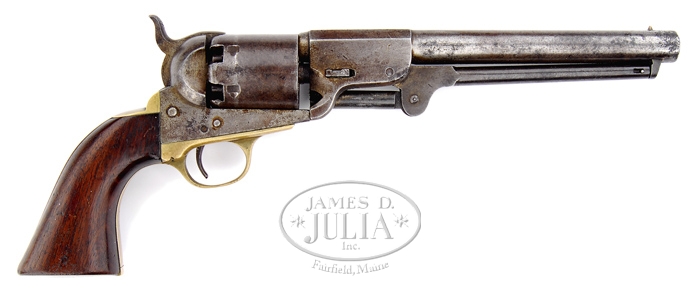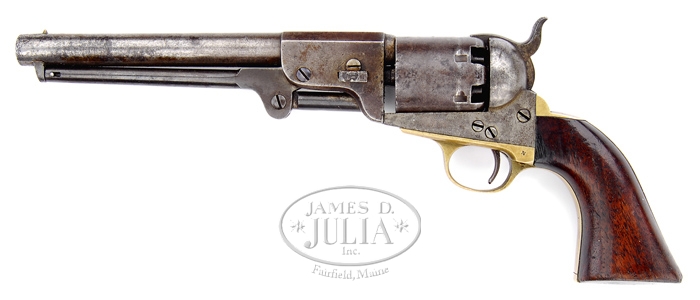



"LEECH AND RIGDON REVOLVER INSCRIBED BY A MISSISSIPPI CAVALRYMAN. SN 346. A fine early serial numbered specimen of this rare Confederate revolver made by Thomas Leech and Charles H. Rigdon in Columbus, Mississippi. Guns with small "Leech & Rigdon" dies such as this under the mid 400 SN range are thought to be made in Columbus, MS before factory was later moved to Georgia. The revolver, serial number 346, generally follows the pattern of the Colt Model 1851 Navy being .36 caliber with a 6-shot cylinder, 7 ½” part round, part octagon barrel marked on the top flat of the barrel’s octagonal breech “LEECH & RIGD-- .” The letters “C.S.A.” are not present either due to a variation in the barrel marking on an incomplete stamp (which is likely because the last two letters of the firm’s name are not visible). Walnut one-piece grips with brass trigger guard and back strap. All marked parts match. In place of the more common 4-dot cross mark on the brass trigger guard, the capital letter “N” is stamped on the left side of the trigger guard. The serial number on the cylinder is unusual and interesting being stamped “346” with an additional “3” above the “4” and an additional “4” below the “3” almost as if the worker could not decide whether to stamp the serial vertically or horizontally. Before the Civil War, Thomas Leech was a cotton trader and Charles H. Rigdon was a scale maker. Together their association would produce for the Confederacy one of the best revolvers of the time that could easily compete with the 1851 Colt Navy, of which it was a direct copy. Thomas Leech is also known to have had other business interests, for some Derringer pistols have survived that are marked "made for Thomas Leech & Co, Memphis, Tenn". He had also founded the Memphis Novelty Works in 1861, a company specialized in the manufacture of cutlery, in particular, a number of Confederate swords. By May, 1862 the company was known as Leech & Rigdon, and was established at Columbus, Mississippi. The partners secured a contract with the Confederate States Government for the manufacture of 1,500 revolvers of the Colt Navy 1851 type. The Leech & Rigdon Company moved from Columbus in December of 1862 due to the impending Union threat. The manufactory was moved to Greensboro, Georgia; and all efforts were concentrated on the manufacture of revolvers. The partnership dissolved for unknown reasons in December, 1863, with a total about 1,500 revolvers produced. Charles Rigdon bought the company's machinery and tools, kept the workers and reinstalled the plant at Augusta, Georgia, where he was joined by Jesse A. Ansley and two other partners, with whom he formed the Rigdon, Ansley & Co. The new company would continue to produce revolvers of the same type for the Confederate army. The original Leech & Rigdon's contract for 1,500 pistols seems to have been achieved, and from serial # 1500 on, the company started the production of guns equipped with a 12 slot cylinders, which are today known as the Rigdon Ansley revolvers. On the back strap appears the name “Thomas Ruddick” which has been hand scratched into the brass. Initial research shows a Thomas Ruddick in the 28th Mississippi Cavalry Regiment, C.S.A. an important Western theater cavalry regiment, a quick glimpse of their history shows that this regiment was organized early in 1862, for three years. The original officers -- Starke, Ferguson and Jones -- were commissioned February 24, 1862; the regiment was reported May 14 in at Camp at Jackson, where it was organized. Colonel Starke was a man of prominence and had organized a cavalry company in his home county, Bolivar, early in 1861. The first active service of the regiment was occasioned by the naval attack on Vicksburg, beginning in May, 1862. Five companies of Starke's Cavalry reinforced Gen. M. L. Smith, at Vicksburg, and were posted to watch the flanks along the Yazoo and below Warrenton on the Mississippi. Later the regiment was at Camp Burrus, in Bolivar County. They operated along the river and in the swamp country, where many contracted fever. At Vicksburg in December, 1862, part of the regiment took part in the Chickasaw Bayou campaign, while the remainder of the regiment, according to Federal reports, was engaged with Steele's expedition from Helena, in the vicinity of Panola, in the same month. In January, 1863, the regiment was assigned Gen. W. T. Martin's Division of cavalry under General Van Dorn, about 7,500 strong, which fought in the campaign in Middle Tennessee early in 1863, supporting General Bragg's army. They were present at the battle of Thompson's Station, March 5, but held in reserve; were in the skirmish with Minty's Cavalry at Thompson's Station, March 9, and actively engaged in the attack on Franklin, April 10. Van Dorn's campaign, during which he lost his life in a private affair, left Mississippi open to Grierson's raid and Grant's advance from Bruinsburg to Jackson and the Yazoo River. The Twenty-eighth, leaving Tennessee May 17, reached Mechanicsburg June 7, a march of 400 miles where they attacked a detachment of the Fourth Iowa Cavalry, under Major Parkell. July 4 the regiment moved from Mechanicsburg to Birdsong's Ferry, and as Johnston's army fell back to Jackson, they skirmished with Sherman’s advance July 7, and fell back covering Johnston's retreat, skirmishing frequently and resisting a charge of cavalry at Clinton. Just before the evacuation of Jackson, July 16, they went to the Federal rear, and recrossed Pearl River after the retreat of Johnston to Morton. After the evacuation of Jackson by Sherman, the regiment was at or near Clinton until moved to Brownsville in September. On October 10th detachments from the 28th were attacked, near Port Gibson by a force of Illinois and Wisconsin Cavalry, whose commanding officer reported 11 of the two regiments killed. October 14th McPherson's expedition set out from Vicksburg intending to go to Canton but on account of the effective resistance made, proceeded no further than Clinton. There were engagements at Brownsville, October 15; on the Canton road near Brownsville, October 15-16; near the Clinton and Vernon cross roads, October 16; at Bogue Chitto Creek, and near Livingston, October 17; and near Clinton, October 18, in which all or parts of the regiment were engaged. After this the regiment was on guard between the Pearl and Big Black Rivers to the close of the year. December 25, 1863, At the outset of Sherman's raid to Meridian, they met the advance of Hurlbut's column giving battle there February 4th. This all was preparatory to the campaign against Atlanta. The regiment moved into Alabama in the spring of 1864. May 5, 1864, the brigade moved from Carthage to Montevallo, Ala.; 14th, arrived at Rome, Ga.; 17th, reached Adairsville and engaged the enemy with considerable loss in killed and wounded; May 20, fought at Cassville, crossed the Etowah, and moved to Dallas, skirmishing. May 28 the brigade was dismounted temporarily and put in the trenches on the extreme south of the line extending from northeast of New Hope Church, southwest of Dallas. After this they skirmished continually as the armies moved to the Marietta line, skirmished on that line and in the Federal rear near Powder Springs, picketed the Chattahoochee River, moved to West Point July 17 to meet Rousseau's expedition, took part in the battle of July 28 near Atlanta, skirmished at Herring's Mill July 30, was in the battle of August 6, and fought near Jonesboro, August 30. In battle at Lawrenceburg, Campbellsville, Columbia, Spring Hill and Franklin; in November, they followed the Federal army to Nashville, thence moved to Murfreesboro, and was particularly distinguished in battle there December 7. In the rear guard of the army during the retreat from Nashville they fought at Columbia, Warfield's, Richland Creek, Pulaski, King's Hill and Sugar Creek, December 22-26. Their commander, Colonel Starke was promoted to Brigadier-General November 4, 1864, and the regiment is assigned to his brigade in General Chalmers' orders of February, 1865. When Gen. J. H. Wilson started on his raid through Alabama and Georgia in March and April, 1865, the brigade moved from Pickensville, Ala., to meet him, and after three days and nights of marching and countermarching arrived near Selma during the assault upon the fortifications there, April 2, but were cut off from the town by the Federal troops and were unable to render any assistance. When Selma was taken they were compelled to retire in the night, thirty miles, across the Cahawba River, after which they moved to Livingston and went into camp. There the last muster rolls were made, up to April 31, 1865. The capitulation by Gen. Richard Taylor occurred May 4, 1865. The cavalry commands under General Forrest were surrendered at Gainesville, Ala., May 22, 1865. With a long and distinguished history, the relationship between this revolver and this famous cavalry unit is remarkable. Mr. Michel’s Notes State: “Not unlike many seemingly strange partnerships in the arms trade, the pairing of Leech & Rigdon joined a scale manufacturer, Charles H. Rigdon, with a cotton grower, Thomas Leech. Apparently their first arms were produced in Greensboro, Georgia. This revolver, serial number 346, has the typical small numbers and barrel marking “Leech & Rigdon” of the company’s early production. Well marked and completely original, that serial number appears on the cylinder, frame, loading lever, loading lever catch, grips, and backstrap. The backstrap is scratch engraved with the name “Thomas Ruddick”. Ruddick was mustered into service on March 9, 1862, at age 27. He joined Capt. George T. Blackburn’s Company of Cavalry, Starke’s Regiment, Mississippi Volunteers (subsequently becoming Company D of the 28th Regiment of the Mississippi Cavalry). He was apparently taken prisoner at Lake Village, Arkansas, on May 14, 1864. Provenance: Catalog of L. C. “Red” Jackson, No. 9, of September 1960.” PROVENANCE: Catalog of L.C. “Red” Jackson #9 of September 1960. CONDITION: Good. All iron parts have a nice dark grey patina which has never been severely cleaned. There is light pitting at the barrel’s muzzle and near the breach. The revolver’s mechanics are fine. Walnut grips show light wear consistent with the metal surfaces of the gun. All serial numbers match. 4-31350 CW11 (25,000-35,000)"
Back to the index
Reloading kit for pinfire cartridges (5mm,7mm, 9mm & 12mm)
How
does it work?
PRICE LIST

|